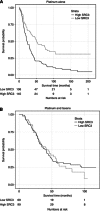Expression of steroid receptor coactivator 3 in ovarian epithelial cancer is a poor prognostic factor and a marker for platinum resistance
- PMID: 23652306
- PMCID: PMC3670494
- DOI: 10.1038/bjc.2013.199
Expression of steroid receptor coactivator 3 in ovarian epithelial cancer is a poor prognostic factor and a marker for platinum resistance
Abstract
Background: Steroid receptor coactivator 3 (SRC3) is an important coactivator of a number of transcription factors and is associated with a poor outcome in numerous tumours. Steroid receptor coactivator 3 is amplified in 25% of epithelial ovarian cancers (EOCs) and its expression is higher in EOCs compared with non-malignant tissue. No data is currently available with regard to the expression of SRC-3 in EOC and its influence on outcome or the efficacy of treatment.
Methods: Immunohistochemistry was performed for SRC3, oestrogen receptor-α, HER2, PAX2 and PAR6, and protein expression was quantified using automated quantitative immunofluorescence (AQUA) in 471 EOCs treated between 1991 and 2006 with cytoreductive surgery followed by first-line treatment platinum-based therapy, with or without a taxane.
Results: Steroid receptor coactivator 3 expression was significantly associated with advanced stage and was an independent prognostic marker. High expression of SRC3 identified patients who have a significantly poorer survival with single-agent carboplatin chemotherapy, while with carboplatin/paclitaxel treatment such a difference was not seen.
Conclusion: Steroid receptor coactivator 3 is a poor prognostic factor in EOCs and appears to identify a population of patients who would benefit from the addition of taxanes to their chemotherapy regimen, due to intrinsic resistance to platinum therapy.
Figures



References
-
- Ahlgren JD, Ellison NM, Gottlieb RJ, Laluna F, Lokich JJ, Sinclair PR, Ueno W, Wampler GL, Yeung KY, Alt D. Hormonal palliation of chemoresistant ovarian cancer: three consecutive phase II trials of the Mid-Atlantic Oncology Program. J Clin Oncol. 1993;10:1957–1968. - PubMed
-
- Alkner S, Bendahl PO, Grabau D, Lövgren K, Stål O, Rydén L, Fernö M, Swedish and South-East Swedish Breast Cancer Groups AIB1 is a predictive factor for tamoxifen response in premenopausal women. Ann Oncol. 2010;21:238–244. - PubMed
-
- Altman DG, Lausen B, Sauerbrei W, Schumacher M. Dangers of using ‘optimal' cutpoints in the evaluation of prognostic factors. J Natl Cancer Inst. 1994;86:829–835. - PubMed
-
- Bai J, Uehara Y, Montell DJ. Regulation of invasive cell behavior by taiman, a Drosophila protein related to AIB1, a steroid receptor coactivator amplified in breast cancer. Cell. 2000;103:1047–1058. - PubMed
-
- Bowman A, Gabra H, Langdon SP, Lessells A, Stewart M, Young A, Smyth JF. CA125 response is associated with estrogen receptor expression in a phase II trial of letrozole in ovarian cancer: identification of an endocrine-sensitive subgroup. Clin Cancer Res. 2002;8:2233–2239. - PubMed
Publication types
MeSH terms
Substances
Grants and funding
LinkOut - more resources
Full Text Sources
Other Literature Sources
Medical
Research Materials
Miscellaneous

